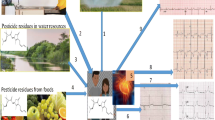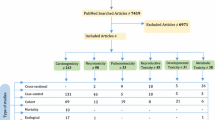Abstract
Cardiovascular disease has maintained the unenviable position as the number one cause of death in the world. It is now clear that the traditional risk factors of cardiovascular disease are driven by primary factors like globalisation, urbanisation, industrialisation and agricultural practices. Pesticide use is an integral component of modern and improved agriculture. The abuse and misuse of these chemicals has caused significant poisoning worldwide and particularly in low- and middle-income countries where Africa belongs. This review surveys the widening population of people poisoned by pesticides in Africa and examines the possibility of pesticide-induced cardiotoxicity. The exposed group includes workers in pesticide industries, transporters of these chemicals, farmers, farm workers who apply these pesticides, vendors and sellers of farm produce and consumers of foodstuffs that are treated with pesticides as well as persons who consume water and inhale air filled with pesticides. There are numerous animal model studies that employ electrocardiography, echocardiography, enzyme studies and histopathology to demonstrate pesticide-induced cardiotoxicity in many parts of the world. There are also case reports and epidemiological data of pesticide-induced cardiovascular intoxication in man. With the increasing reports of pesticide-induced central system nervous toxicity in Africa, there are enough reasons to suspect cardiovascular system poisoning as well. The poorly developed clinical toxicology specialty may explain the low index of suspicion of pesticide-induced cardiovascular diseases. With the pervading ignorance, indiscriminate sale, unguarded use, lack of adequate legislation, inadequate enforcement of legal institutes associated with pesticide use in Africa, there is no doubt that the increasing prevalence and incidence of cardiovascular diseases may partly be due to exposure to these chemicals. Africans may after all be at risk of pesticide-induced cardiotoxicity, but more studies will be required to examine the pattern of cardiotoxicity as well as factors that modulate its occurence.
Similar content being viewed by others
References
Smith, S. C. Jr., Collins, A., Ferrari, R., et al. (2012). Our time: A call to save preventable death from cardiovascular disease (heart disease and stroke). Journal of the American College of Cardiology. https://doi.org/10.1016/j.jacc.2012.08.962.
World Health Organization (WHO). (2012). Cardiovascular disease: Global atlas on cardiovascular disease prevention and control. Geneva: WHO.
Smith, S. C. Jr., Collins, A., et al. (2012). World Heart Federation. Urbanization and Cardiovascular Disease: Raising Heart-Healthy Children in Today’s Cities. Geneva: WHF.
Pesticide Action Network (PAN). (2010). Pesticide health risks for South African emerging farmers Surplus people project. http://www.spp.org.za.
Donaldson, D., Kiely, T., Grube, A. Pesticide’s industry sales and usage 1998–1999 market estimates. US Environmental Protection Agency; Washington (DC): Report No. EPA-733-R-02-OOI. Available from http://www.epa.gov/oppbead/pesticides/99pestsales/market-estimates.pdf.
de Vos, B. J., Fernandes-Whaley, M., Roos, C., et al. Pesticide use in South Africa: One of the largest importers of pesticides in Africa. https://www.intechopen.com/books/pesticides-in-the-modern-world-pesticides-use-and-management/pesticide-use-in-south-africa-one-of-the-largest-importers-of-pesticides-in-africa.
Gupta, S. K., Bang, C., & Thum, T. (2010). Circulating microRNAs as biomarkers and potential paracrine mediators of cardiovascular disease. Circulation, 3, 484–488.
Erhunmwunse, N. O., Dirisu, A., & Olomukoro, J. O. (2012). Implications of pesticide usage in Nigeria. Tropical Freshwater Biology, 21(1), 15–25.
Teixeira, D., Pestana, D., Santos, C., et al. (2015). Inflammatory and cardiometabolic risk on obesity: Role of environmental xenoestrogens. Journal of Clinical Endocrinology and Metabolism, 100(5), 1792–1801.
Georgiadis, N., Tsarouhas, K., Tsitsimpikou, C., et al. (2018). Pesticides and cardiotoxicity: Where do we stand? Toxicology and Applied Pharmacology, 353, 1–14.
UNEP. (2004). Childhood Pesticide poisoning, information for Advocacy and Action. Prepared for the United Nations Environment Programme (UNEP), United Nations Environment Programme (UNEP Chemicals) with the assistance of UNEP’s Information Unit for Conventions.
Bar-Meir, E., Schein, O., Eisenkraft, A., et al. (2007). Guidelines for treating cardiac manifestations of organophosphates poisoning with special emphasis on long QT and Torsades de pointes. Critical Reviews in Toxicology, 37(3), 279–285.
Mills, K. T., Blair, A. B., Freeman, L. E., et al. (2009). Pesticides and myocardial infarction incidence and mortality among male pesticide applicators in the Agricultural Health Study. American Journal of Epidemiology, 170(7), 892–900. https://doi.org/10.1093/aje/kwp214.
Roth, A., Zellinger, I., Arad, M., et al. (1993). Organophosphates and the heart. Chest, 103(2), 576–582.
Saadeh, A. M., Farsakh, N. A., & al-Ali, M. K. (1997). Cardiac manifestations of acute carbamate and organophosphate poisoning. Heart, 77(5), 461–464.
Pan, L., Xu, M., Yang, D., et al. (2017). The association between coronary artery disease and glyphosate exposure found in pesticide factory workers. Journal of Public Health and Emergency, 1, 4. https://doi.org/10.21037/jphe.2016.12.04.
Donelly, J., & Adeyemi, S. A. (1970). Handbook of agricultural insecticides available in Nigeria. The Ministry of Agriculture and Natural Resources, Western State of Nigeria and The Entomological Society of Nigeria, http://www.1970-agris.fao.org.
Garcial, F. P., Ascencio, S. Y., Gaytan Oyarzun, J. C. et al. (2012). Pesticides: Classification, uses and toxicity. Measures of exposure and genotoxic risks. Journal of Research in Environmental Science and Toxicology, 1(11), 279–293.
Globally Harmonized System of Classification and Labelling of Chemicals (UNCETDG/GHS) United Nations, 2011. http://www.unece.org/trans/danger/publi/ghs/implementation_e.html. http://www.unece.org/trans/danger/danger.htm. http://www.unece.org/trans/danger/publi/ghs/ghs_welcome_e.html.
Announce http://www.mordorintelligence.com/crops.
Sheahan, M., & Barrett, C. B. (2014). “Understanding the Agricultural Input Landscape in Sub-Saharan Africa: Recent Plot, Household, and Community-Level Evidence.” Policy Research Working Paper No. 7014. Washington, DC: World Bank.
Popp, J., Pető, K., Nagy, J. (2013). Pesticide productivity and food security. A review. Agronomy for sustainable Development, 33(1), 243–255.
Ojo, J. (2016). Pesticides use and health in Nigeria. Ife Journal of Science, 18(4), 981–991.
Vandekar, M. (1965). Observations on the toxicity of carbaryl, Folithion and 3-isopropyl N-methylcarbamate in a village-scale trial in southern Nigeria. Bulletin of the World Health Organization, 33, 107–115.
Osibanjo, O., & Adeyeye, A. (1995). Organochlorine pesticide residues in cereals in Nigerian markets. Bulletin of Environmental Contamination and Toxicology, 54, 460–465.
thenationonlineeng.net. Rilwan 19 july 2015. Experts recipe for beans pest.
The point. (2016). http://thepoint.com. Olukemi Adeboye.
Leonila, M. V. (2002). Impact of agrochemical on soil and water quality. National crop protection centre, university of the Philippines at Los Banos. http://www.fftc.agnet.org/index.php.
Osibanjo, O., Biney, C., Calamari, N., et al. (1994). Chlorinated Hydrocarbon substances. Flood and Agriculture Organisation Fish Report, 502, 2.
PAN Pesticide database. (2011). http://www.pesticideinfo.org. Accessed 20 Mar 2011.
International Trade Centre. (2011). Country market analysis profile, 20.03.2011. Available from http://www.intracen.org.
Mbakaya, C. F., Ohayo-Mitoko, G. J., Ngowi, V. A., et al. (1994). The status of pesticide usage in East Africa. African Journal of Health Science, 1(1), 37–41.
Sinyangwe, D. M., Mbewe, B., & Sijumbila, G. (2016). Determination of diclorvos residue levels in vegetables sold in Lusaka, Zambia. Pan African Medical Journal, 23, 113.
Ababio, P. F., & Lovatt, P. (2014). A review on food safety and food hygiene studies in Ghana. Food Control, 47, 92–97.
Christian Aid. (2012). Pesticide misuse a major threat to farmers health and food safety. http://allafrica.com/stories/201204200319.html. Accessed 24 Jan 2018.
NPA. Northern Presbyterian Agricultural Services and partners. (2012). ‘Ghana’s pesticide crisis: A need for further government action. http://www.christianaid.org.uk/images/ghanaspesticide-crisis.pdf. Accessed 24 Jan 2018.
Omari, R., & Frempong, G. (2016). Food safety concerns of fast food consumers in urban Ghana. Appetite, 98, 49–54.
Atuhaire, A. (2017). Tackling pesticide exposure in subSaharan Africa: A story from Uganda. Outlooks on Pest Management, 28(2), 61–64.
United Nations. (2017). Sustainable development goals report. http://www.un.org. Accessed 14 Mar 2018.
Jeyaratnam, J. (1990). Acute pesticide poisoning: A major global health problem. World Health Statistics Quarterly, 43(3), 139–144.
Asogwa, E. U., & Dongo, I. N. (2009). Problems associated with pesticide usage and application in Nigeria cocoa production: A review. African Journal of Agricultural Research, 4(8), 675–683.
Ivbijaro, M. F. A. (1990). Natural pesticides: Role and production potential in Nigeria. National workshop on the pesticide industry in Nigeria, University of Ibadan.
Ivbijaro, M. F. A. (1998). Natural pesticides: National programme on Agrotechnology: A keynote address presented at the Centre for Agricultural technology. University of Agriculture Makurdi.
https://spp.org.za/wp-content/uploads/2016/07/pesticide_booklet.pdf.
Maheshwari, M., & Chaudhary, S. (2017). Acute atrial fibrillation complicating organophosphorous poisoning. Case Report, 18(3), 96–99. https://doi.org/10.4103/1995-705X.217856.
Ludomirsky, A., Klein, H. O., Sarelli, P., Becker, B., Hoffman, S., & Taitelman, U. (1982). Q-T prolongation and polymorphous (torsades de pointes) ventricular arrhythmias associated with organophosphorous insecticide poisoning. American Journal of Cardiology, 48, 1654–1658.
Paul, U. K., & Bhattacharyya, A. K. (2012). ECG manifestations of acute organophosphorous poisoning. Journal of the Indian Medical Association, 110(98), 107–108.
Pappano, A. J. (2015). Cholinoreceptor-blocking drugs. In B. G. Katzung & A. J. Trevor (Eds.), Basic and clinical pharmacology, Lange 2015 (13th ed., pp. 121–132). New York: McGraw-Hill.
Chan, Y. C., Chang, S. C., Hsuan, S. L., et al. (2007). Cardiovascular effects of herbicides and formulated adjuvants on isolated rat aorta and heart. Toxicology In Vitro, 21, 595–603.
Chen, Q., Reis, S. E., Kammerer, C. M., et al. (2003). Association between the severity of angiographic coronary artery disease and paraoxonase gene polymorphisms in the National Heart, Lung, and Blood Institute-sponsored Women’s Ischemia Syndrome Evaluation (WISE) study. The American Journal of Human Genetics, 72, 13–22.
Lee, H. L., Kan, C. D., Tsai, C. L., et al. (2009). Comparative effects of the formulation of glyphosate-surfactant herbicides on hemodynamics in swine. Clinical Toxicology (Phila), 47, 651–658.
Seok, S. J., Park, J. S., Hong, J. R., et al. (2011). Surfactant volume is an essential element in human toxicity in acute glyphosate herbicide intoxication. Clinical Toxicology (Phila), 49, 892–899.
Song, H. Y., Kim, Y. H., Seok, S. J., et al. (2012). In vitro cytotoxic effect of glyphosate mixture containing surfactants. Journal of Korean Medical Science, 27, 711–715.
Vincent, K., & Davidson, C. (2015). The toxicity of glyphosate alone and glyphosate-surfactant mixtures to western toad (Anaxyrus boreas) tadpoles. Environmental Toxicology and Chemistry, 34, 2791–2795.
Wahab, A., Hod, R., Ismail1, N., et al. (2016). The effect of pesticide exposure on cardiovascular system: A systematic review. International Journal Of Community Medicine And Public Health, 3(1), 1–10. http://www.ijcmph.com.
Campbell, B. N. (2000). Glyphosphate. In A. Campbell (Ed.), Handbook of poisoning in dogs and cat (1st ed.). Hoboken: Blackwell Science Ltd.
Mahendrakar, K., Venkategowda, P. M., Rao, M., et al. (2014). Glyphosphate surfactant herbicide poisoning and management. Case Report, 18(5), 328–330. https://doi.org/10.4103/0972-5229.132508.
Noguchi, N., Tanaka, E., Yamamoto, H., et al. (1990). Initial accumulation of paraquat in the heart leading to acute death. Nihon Hoigaku Zasshi (Japanses Journal of Legal Medicine), 44, 6–11.
Gawarammana, I. B., & Buckley, N. A. (2011). Medical management of paraquat ingestion. British Journal of Clinical Pharmacology, 72, 742–757.
Kang, M. S., Gil, H. W., Yang, J. O., et al. (2009). Comparison between kidney and hemoperfusion for paraquat elimination. Journal of Korean Medical Science, 24, S156–S160.
Soderlund, D. M. (2010). Toxicology and mode of action of pyrethroid insecticides. In Hayes handbook of pesticide toxicology (pp. 1665–1686). https://doi.org/10.1016/B978-0-12-374367-1.0077-X.
Pesticide Action Network (PAN). (2016). Pesticide health risks for South African emerging farmers Surplus people project.
Pruss-Ustun, A., & Corvalan, C. (2006). Preventing disease through healthy environments: Towards an estimate of the environmental burden of disease. Geneva: World Health Organization.
Judson, R., Houck, K., Martin, M., et al. (2016). Editor’s highlight: Analysis of the effects of cell stress and cytotoxicity on invitro assay activity across a diverse chemical and assay space. Toxicology Science, 152, 323–339.
Wesseling, C., McConnell, R., Partanen, T., & Hogstedt, C. (1997). Agricultural pesticide use in developing countries: Health effects and research needs. International journal of health services, 27(2), 273–308. https://doi.org/10.2190/E259-N3AH-TA1Y-H591.
Ozlem, O. (2013). Cardiotoxicity and apoptotic activity in subacute endosulfan toxicity and the protective effect of vitamin c in rabbits: A pathological study. Journal of Environmental Pathology, Toxicology and Oncology, 32(1), 51–58.
Author information
Authors and Affiliations
Corresponding author
Ethics declarations
Conflict of interest
The authors declare that they have no conflicts of interests.
Additional information
Handling Editor: Dipak K Dube.
Rights and permissions
About this article
Cite this article
Anakwue, R. Cardiotoxicity of Pesticides: Are Africans at Risk?. Cardiovasc Toxicol 19, 95–104 (2019). https://doi.org/10.1007/s12012-018-9486-7
Published:
Issue Date:
DOI: https://doi.org/10.1007/s12012-018-9486-7




